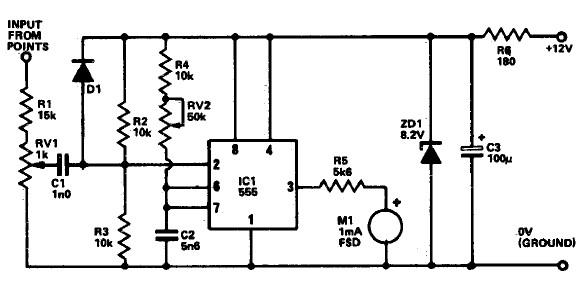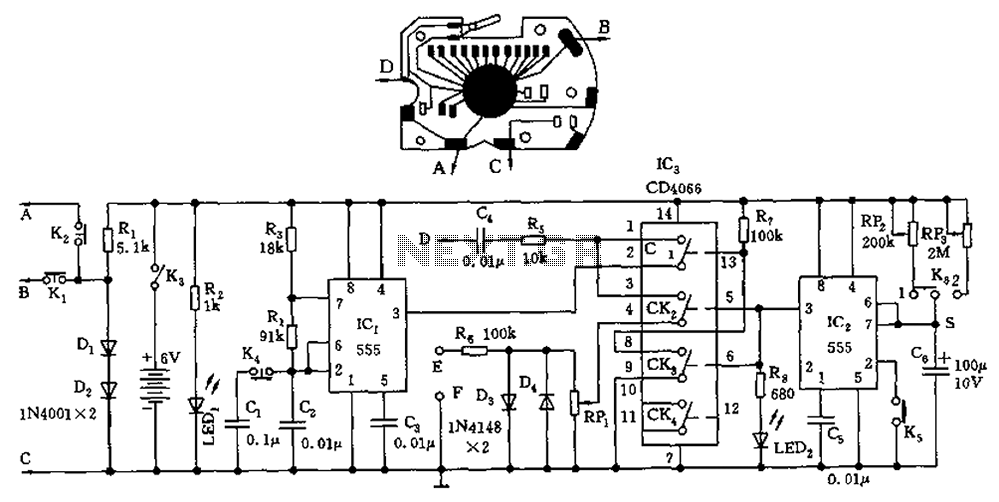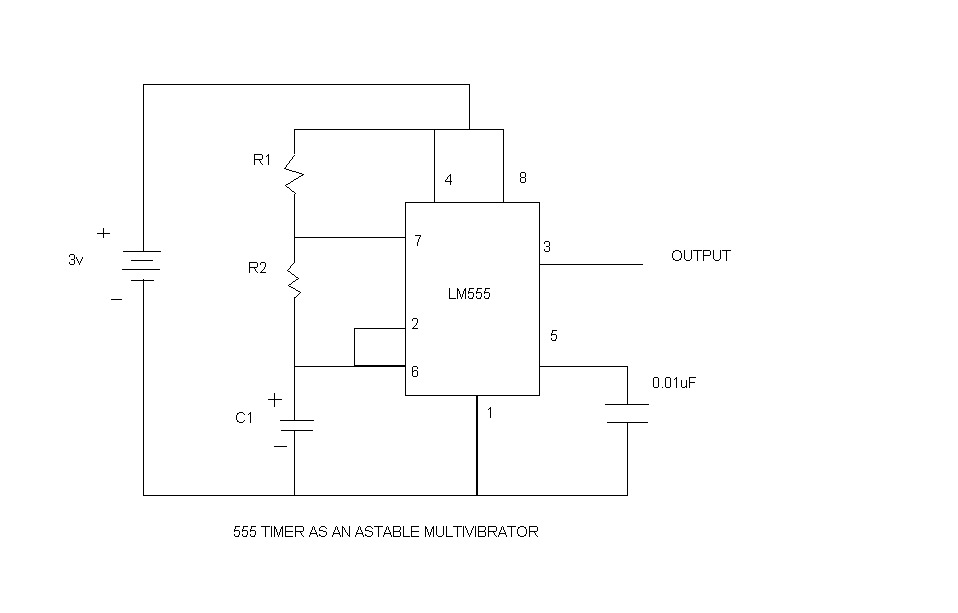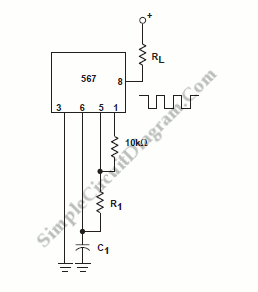
555 1 Hz pulse generator
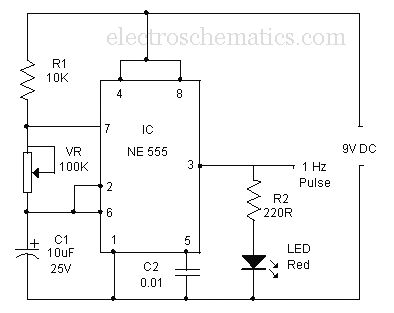
A simple buzzer is being converted into an oscillating buzzer to produce a sound similar to that of an automobile's reverse indicator. The schematic provided is borrowed from electroschematics.com. The intention is to replace the LED in the circuit with a buzzer and omit the resistor. The goal is to build this circuit to make the buzzer emit sound at an interval of 1 second, as it functions as a 1 Hz pulse generator. There is uncertainty regarding the current requirements of the buzzer, as it is housed in a black plastic casing with no markings. To avoid potential shortages, the resistor has been omitted. The buzzer operates within a wide voltage range of 3 to 12 volts, suggesting that excessive current may not pose a problem. However, caution is advised as the 555 timer cannot supply unlimited power. It is recommended to measure the current of the buzzer to ensure compatibility. While equations exist for calculating resistor values for desired output, empirical experimentation has been the preferred method for determining the appropriate capacitor value for achieving the desired output. The values of resistors R1 and VR can affect the duty cycle, which is the ratio of on-time to off-time of the waveform. If the circuit produces a one-second pulse but results in a brief "on-pulse" followed by a longer off-pulse, a variable resistor should replace R1, allowing for adjustments until the desired duty cycle is achieved. The 555 timer circuit will produce a one-second pulse, but may not generate the desired tone. It is important to ensure that the current drain of the buzzer does not exceed the available amperage from the 555 timer. If necessary, a small transistor, such as a 2N3904, may be used to drive the buzzer. There is also a query regarding whether an additional amplifier for the buzzer should be placed before or after the 555 timer, with a suggestion that it should be positioned before the timer.
The circuit utilizes a 555 timer in astable mode to generate a square wave output that drives the buzzer. The 555 timer is configured with resistors R1 and R2, and a timing capacitor C1, which together determine the frequency and duty cycle of the output waveform. The frequency of oscillation can be calculated using the formula:
\[ f = \frac{1.44}{(R1 + 2 \cdot R2) \cdot C1} \]
Where \( f \) is the frequency in Hertz, \( R1 \) and \( R2 \) are in ohms, and \( C1 \) is in farads. A variable resistor (potentiometer) can be used for R1 to allow fine-tuning of the duty cycle, which is essential for achieving the desired sound characteristics of the buzzer.
The buzzer should be connected to the output pin of the 555 timer, ensuring that the current drawn by the buzzer does not exceed the output current capability of the timer, typically around 200 mA. If the buzzer requires more current, a small NPN transistor, such as the 2N3904, can be employed to switch the buzzer. The base of the transistor would be connected to the output pin of the 555 timer through a current-limiting resistor, while the buzzer would be connected to the collector of the transistor, with the emitter grounded.
For applications requiring additional amplification, it is advisable to place the amplifier circuit after the 555 timer. This configuration allows the timer to control the amplifier, ensuring that the amplified signal can drive the buzzer effectively without overloading the 555 timer. Proper attention to component ratings and circuit layout will ensure reliable operation and desired sound output from the buzzer circuit.A simple buzzer to convert to an oscillating buzzer so as to obtain the sound similar to that of an automobile`s reverse indicator. I`ve posted a schematic(borrowed from electroschematics. com) below. I intent to replace the LED with my buzzer and omit the resistor. I hope by building this circuit, to make my buzzer `buzz`(or make noise) at an interval of 1 second(since its a 1
Hz pulse generator). Would the results be similar to my needs Thank you Steve. I had checked for its current requirements but the device came in a black plastic containment with nothing marked on it. I am not sure of its current requirements and hence decided to omit the resistor to prevent any shortage.
Since its a buzzer that runs on a wide range of voltage input(3 volts-12 volts), I figured a bit too much current wouldn`t be a problem either. It will be a problem for the 555 ! It can`t supply an infinite amount of power. You MIGHT get away with just the chip. Measure the current of the buzzer on your bench. There are EQUATONS to calculate the resistors for desired output, but I bypassed those many years ago and just did experiments to determine aproximate value for the charging capacitor to get desired output.
Here are my results: Also, for the values of resistors R1 and VR can effect the DUTY-CYCLE. That is the ratio of ON-TIME to the OFF-TIME of the waveform. If the thing you build seems to pulse at ONE second, but it is only a quick "ON-PULSE" then the OFF PULSE seems to last a lot longer. you need to place a variable resistor in place of the R1 resistor and adjust the two variable resistors untill you get the desired DUTY-CYCLE.
The 555 circuit you are building will put out a one second pulse, but will not make the TONE you want to hear. But you say you are using a BUZZER for that or just lighting an LED. Be sure the current drain of the buzzer is not more than the amperes available from the 555 timer (which isn`t much).
You may have to make the 555 output drive a small general transistor like a 2n3904 which will power the buzzer. And hey, If I had to add an additional amplifier for the buzzer, should it go before the 555 timer or after.
I think it should be before the timer but correct me if I`m wrong 🔗 External reference
The circuit utilizes a 555 timer in astable mode to generate a square wave output that drives the buzzer. The 555 timer is configured with resistors R1 and R2, and a timing capacitor C1, which together determine the frequency and duty cycle of the output waveform. The frequency of oscillation can be calculated using the formula:
\[ f = \frac{1.44}{(R1 + 2 \cdot R2) \cdot C1} \]
Where \( f \) is the frequency in Hertz, \( R1 \) and \( R2 \) are in ohms, and \( C1 \) is in farads. A variable resistor (potentiometer) can be used for R1 to allow fine-tuning of the duty cycle, which is essential for achieving the desired sound characteristics of the buzzer.
The buzzer should be connected to the output pin of the 555 timer, ensuring that the current drawn by the buzzer does not exceed the output current capability of the timer, typically around 200 mA. If the buzzer requires more current, a small NPN transistor, such as the 2N3904, can be employed to switch the buzzer. The base of the transistor would be connected to the output pin of the 555 timer through a current-limiting resistor, while the buzzer would be connected to the collector of the transistor, with the emitter grounded.
For applications requiring additional amplification, it is advisable to place the amplifier circuit after the 555 timer. This configuration allows the timer to control the amplifier, ensuring that the amplified signal can drive the buzzer effectively without overloading the 555 timer. Proper attention to component ratings and circuit layout will ensure reliable operation and desired sound output from the buzzer circuit.A simple buzzer to convert to an oscillating buzzer so as to obtain the sound similar to that of an automobile`s reverse indicator. I`ve posted a schematic(borrowed from electroschematics. com) below. I intent to replace the LED with my buzzer and omit the resistor. I hope by building this circuit, to make my buzzer `buzz`(or make noise) at an interval of 1 second(since its a 1
Hz pulse generator). Would the results be similar to my needs Thank you Steve. I had checked for its current requirements but the device came in a black plastic containment with nothing marked on it. I am not sure of its current requirements and hence decided to omit the resistor to prevent any shortage.
Since its a buzzer that runs on a wide range of voltage input(3 volts-12 volts), I figured a bit too much current wouldn`t be a problem either. It will be a problem for the 555 ! It can`t supply an infinite amount of power. You MIGHT get away with just the chip. Measure the current of the buzzer on your bench. There are EQUATONS to calculate the resistors for desired output, but I bypassed those many years ago and just did experiments to determine aproximate value for the charging capacitor to get desired output.
Here are my results: Also, for the values of resistors R1 and VR can effect the DUTY-CYCLE. That is the ratio of ON-TIME to the OFF-TIME of the waveform. If the thing you build seems to pulse at ONE second, but it is only a quick "ON-PULSE" then the OFF PULSE seems to last a lot longer. you need to place a variable resistor in place of the R1 resistor and adjust the two variable resistors untill you get the desired DUTY-CYCLE.
The 555 circuit you are building will put out a one second pulse, but will not make the TONE you want to hear. But you say you are using a BUZZER for that or just lighting an LED. Be sure the current drain of the buzzer is not more than the amperes available from the 555 timer (which isn`t much).
You may have to make the 555 output drive a small general transistor like a 2n3904 which will power the buzzer. And hey, If I had to add an additional amplifier for the buzzer, should it go before the 555 timer or after.
I think it should be before the timer but correct me if I`m wrong 🔗 External reference
